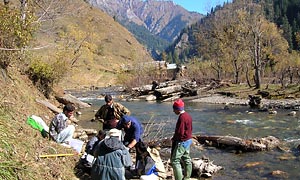Trophic ecology and adaptive management of the aquatic ecosystem of Pyramid Lake, Nevada
Date:
2011-2017
Abstract:
Pyramid Lake, Nevada is one of the last remaining strongholds for lacustrine Lahontan cutthroat trout (Oncorhynchus clarkii henshawi; LCT); almost all other large lake populations have undergone population declines or extirpation as a result of habitat degradation, over-harvest, and water diversions, all compunded by the stocking of non-native species. Pyramid Lake is also home to several other important native and endemic fishes (e.g., cui ui; Chasmistes cujus). Lahontan cutthroat trout support a very popular fishery, managed by the Pyramid Lake Paiute Tribe. The population currently depends almost entirely on stocking programs and efficient management. In 2015, we completed a comprehensive research project driven by critical uncertainties surrounding the performance of the fishery and stocked LCT across space and time, the role of exotic Sacramento perch (Archioplites interruptus), the potential for native forage fish recovery, and the link between fish performance and lake productivity and carrying capacity. In addition, two different strains of LCT have been stocked into Pyramid Lake since 2006: Pilot Peak and Pyramid Lake strains, with a variety of tagging and stocking protocols and no to little post-hoc evaluation of their relative performance completed to date. The results and conclusions of that study were provided in Heredia (2014) and Budy et al. (2014) and provide the foundation for many of the recommendations provided for management. We have shown LCT that almost 80% of LCT diet is tui chub. LCT in Pyramid Lake are voracious predators at the very top of the food web and are growing at rates near their maximum possible. We used bioenergetic analyses to estimate annual consumption of LCT on tui chub. Based on those analyses, we estimate an average individual LCT consumes 65 tui chub per year. The population of LCT in Pyramid Lake are consuming about 60-76% of the tui chub production biomass available each year. As such, they have not exceeded their carrying capacity, a good thing from a management perspective, as this ensures rapid growth rates and high quality fish. However, there is some evidence that the abundance of tui chub, their primary food source, is declining over time. Tui chub declines may be associated with declining lake level, which causes negative increases in total dissolved solids (like in Walker Lake) and losses in shoreline habitat critical for spawning and rearing. Managing LCT means managing tui chub. A draft Adaptive Management Plan is currently under review by the Lahontan National Fish Hatchery Complex, U.S. Fish and Wildlife Service, Pyramid Lake Fisheries, and the Paiute Tribe.
Funding:
- Lahontan National Fish Hatchery Complex, US Fish and Wildlife Service.
- Pyramid Lake Fisheries and the Paiute Tribe
- US Geological Survey – Utah Cooperative Fish and Wildlife Research Unit (In-kind)
Investigators:
- Phaedra Budy, Principal Investigator, USGS – UCFWRU – Dept. of Watershed Sciences and the Ecology Center
- Nick Heredia, Post-graduate researcher, USU - Dept. of Watershed Sciences
- Gary P. Thiede, Researcher, USU - Dept. of Watershed Sciences
- Jereme Gaeta, Assistant Professor, USU - Dept. of Watershed Sciences and the Ecology Center
- Bryan Maloney, Post-graduate researcher, USU - Dept. of Watershed Sciences




